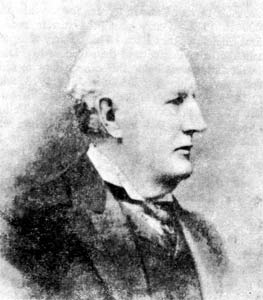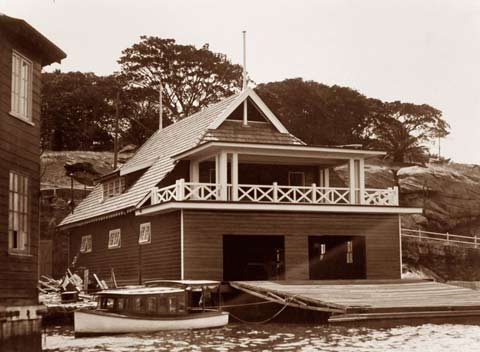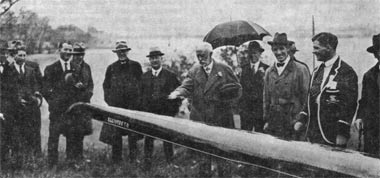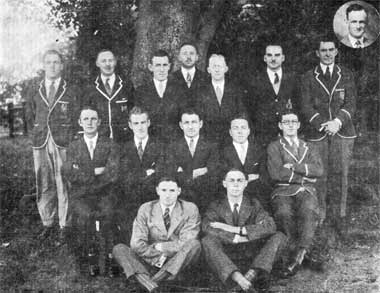
Sydney Rows
A Centennial History of the Sydney Rowing Club, 1970, by A L May
Table of Contents
Chapters
- Preliminaries: before 1870
- Foundations: 1870-1880
- New Clubs: 1880-1890
- The Amateur Question: 1890-1900
- Sydney on Top: 1900-1910
- Henley and War: 1910-1920
- Pearce and Mosman: 1920-1930
- Financial Problems: 1930-1940
- War and Wood: 1940-1950
- Strength and Stability: 1950-1960
- On Top Again: 1960-1970
Appendices
7. Pearce and Mosman: 1920-1930
For Sydney, as for so many other clubs, success on the river in the first half of the decade was hard to come by. By 1925/26, however, the club was clearly on the way back despite the excellence of the competition still provided by the Mosman club. In 1926/27, SRC won the junior pennant and was a clear second in the premiership. The identical performance was recorded in 1928/29, while the club was second in the premiership once again in 1929/30. And in 1928, the club - and Australia - had the pleasure of seeing its Olympic sculling representative, Bob Pearce, bring home a gold medal.
A number of outstanding supporters of the club for many years were taken by death during the decade. Sir Thomas Dibbs, a vice-president since 1873, died in 1923 at the age of 90. Jim Oatley, a foundation member, died in 1925, while two vice-presidents, Dr. Alfred Burne and Richard Teece, the latter a former general manager of the A.M.P. Society, both passed on. John Ryrie, a member of the 1912 Henley and Olympic crews, was killed while playing polo.

Sir Thomas Dibbs
The loss most keenly felt was, however, the death of Deloitte on 7 April, 1929, at the age of 85. Only three years before, he had devoted another twelve months to a tour through South-East Asia and England, taking in, of course, Henley Royal Regatta once again. Sydney's first captain, he was a vice-president from 1878 till 1902 when he became president. He was also elected president of the NSWRA in 1902, and held both posts till his death. A keen regatta official for many years, he was the staunchest of supporters of all rowing clubs and all rowing activities. The death of the much-loved "father of rowing" was much regretted by all. A large crowd, which included the Prime Minister of the Commonwealth, attended his funeral.
It was Sydney's turn for a club house tragedy. In March, 1922, fire destroyed the club's shed at Woolloomooloo Bay, with a substantial portion of the fleet and many valuable records being lost. Fortunately, the club was well protected by insurance and the claim was paid in full. A new shed was constructed on the same site and was officially opened in November of the same year.

The new boatshed at the Branch
There were also developments at the Branch. In 1927/28, the club advised the RA that the Branch had been "reorganised and is now complete with new billiard, dining and lounge rooms and crew dormitories, tobacco and liquor licenses, a tennis court in first-class condition, as well as the boat house and pontoon". The committee invited other clubs to use the Branch facilities, including dining and accommodation, on giving appropriate notice.
Nineteen craft were lost in the fire. They were three eights, a new regulation four, two practice fours, two double sculls, seven club skiffs, two best sculling boats and a couple of pleasure skiffs. A new racing four, presented to the club only a month before the fire, was, fortunately, not lost. This was the Chard, presented by W. H. Chard, an old member of the club. A new four, the Q. L. Deloitte, was christened in January, 1925 and a regulation four was purchased in 1925/26, largely through the generosity of E. A. Pearson. In May, 1928, C. H. Kloster, a top oarsman of the late 'nineties, presented the club with a new racing eight which was named, at his request, the Q. L. Deloitte II. By the end of June, 1930, the fleet was back up to 22 craft: four racing eights, a practice eight, two best and best fours, five regulation fours, three pair oars and seven gladstone skiffs. In 1927/28, three eights, a regulation four, two pairs and a skiff were being housed at the Branch. Housing of the RA's eight by the club was also a common practice during the decade.

Christening of the Q L Deloitte in 1925
Among those present are Cyril Bluett (third from left, holding hat), Tom Mulholland (on left of Deloitte) and Bill Watson (next to Mulholland).
Club membership grew rapidly in the second half of the decade. From 191 in June, 1925, it rose to a peak of 305 in June, 1928, then dipping to 282 at the end of the decade. As at June, 1928, there were 52 life members, 163 active members and 90 associates. Branch receipts totalled ₤835 in 1925,/26 and were up to £1,143 in 1928/29. Subscriptions in the latter year totalled ₤728 with the club showing a small surplus (₤72) on overall operations. The mortgage on the Abbotsford property stood at ₤850 in June, 1926 and remained at this level until the end of the decade. Debentures outstanding in June, 1926 totalled ₤411 but were down to £300 by March, 1930 (the club's financial year was altered from July-June to April-March in 1929/30). The club's assets in 1930 were valued at ₤6,171, the major items being club house and land, Abbotsford, ₤3,500; club house, Domain, ₤1,290; and fleet ₤714. Assets exceeded liabilities by ₤4,598.
The election of a new president - only the third in 59 years - became necessary on the death of Deloitte. The vice-presidents met together at the Hotel Australia on 21 June, 1929 to consider a successor and their choice fell on C. A. Smith. Clarrie Smith, a top club and colonial oarsman in the late 1890's, had previously served the club as committeeman, treasurer, vice-captain, captain and, since 1900/01, vice-president.
A number of additional names were added to the list of vice-presidents during the decade, the list totalling 23 at the end of the period. The new vice-presidents were O. H. Baass, A. W. Shadforth, W. H. Chard, A. C. Ebsworth, G. E. Fairfax, H. H. Massie, F. T. D. Meares, A. W. Cains, E. L. Lamont, P. A. McIntosh, C. H. Kloster, R. B. Fitzhardinge, H. F. Pike and C. M. Moesch.
Both State Governors during the decade, Sir Walter Davidson and Sir Dudley de Chair, extended their patronage to the club and Sir Walter performed the opening ceremony of the new Domain shed in 1922. Four persons held the position of captain during the decade: Fred Meares (three years), Tom Mulholland (two), Owen Hogg (two) and Cyril Bluett (three). Holders of the other executive positions changed almost annually, with only Bert Goulding (vice-captain) and L. C. Wilson (treasurer) holding the one position for a period of two years.
Long-term committee members during the decade included Harry Pike, Ernie Ireland, Charlie Moesch, Doug Bowman, Dan Neylon, Jack McCaffery and Arthur Cashman. During 1927/28, the Branch was, for the first time in the club's history, used generally for committee meetings.
A great deal of emphasis was placed on social functions, with a keen group of ladies assisting in organisational matters. The annual ball was a major feature each year. In 1925 there were over 400 present (at the Wentworth) and in both 1927 and 1928 the attendance exceeded 550. Small dances were also arranged, with Douglas Lamotte very prominent in their organisation. The ball and the dances normally contributed quite significantly to the club's funds as well: the 1928 ball, held at David Jones' Ballroom in the presence of His Excellency the Governor and Lady de Chair, showed a net profit of £117.
After 1926, tennis parties became both possible and popular once again and tournaments were conducted from time to time. Billiard tournaments were also held. No regular annual dinner took place but a number of small dinners were conducted on special occasions, normally to honour a member or members.
Winter racing by club members became firmly established during the decade. By 1925/26, a point score competition during the winter had emerged, with a series of pair-oar races and four-oar races being held on Saturdays at fortnightly intervals. By the winter of 1927, members were being graded into "A" and "B" divisions, with the "A", or senior, members competing in eights for the "Q. L. Deloitte Cup" and the "B", or new, members in fours for a trophy initially presented by Bob Turnbull. A third race, a pair-oar event for novices, was added in 1930, Bert Goulding was the first winner of the Deloitte Cup, with Geoff Bates winning in 1928, Harry Gilmour in 1929 and Ted Downie and Jack Langley dead-heating in 1930. Gladstone skiff competitions were also held from time to time.

The Club Committee of 1928-29
Back row (left to right): K O Preshaw, H Pike, T P Mulholland, H Carpenter, A Johnson, G Denison, E Ireland. Front row: C Rosevear, S R Turnbull, C Bluett, W A Goulding, R H Bellamy. On ground: D G Lamotte, W P Green. Inset: C O Litchfield.
The brunt of the coaching load at the club in the early years of the decade was borne by Ernie Keary and by George MacKenzie, a former Tasmanian interstate coach. Claude Rosevear, also formerly of Tasmania, transferred to SRC in 1926 and commenced coaching with considerable success. For the 1928/29 and 1929/30 seasons, the club departed from its usual practice of appointing a selection committee and appointed Rosevear sole selector. Strong coaching support also came from Bill Goulding, his two sons Bert and Jack, Charlie Saleh, Cliff Lambert, Tom Mulholland, Charlie Litchfield and, late in the decade, George Hancock.
Other Clubs
The decade belonged without question to Mosman. The 1920/21 season was the only one in which the club failed to win the premiership and even then it came second. It also won the junior pennant in 1925/26 and 1929/30. Membership in 1926 totalled only 87 with an "effective fleet" of 12 boats but both improved thereafter. Extensive work on the foundations of the club house were needed in the middle of the decade while, in 1927, a Boat House Fund to construct a new shed - the old one by then being over fifty years of age - was commenced.
Leichhardt did very well early in the decade, winning the premiership and the junior pennant in 1920/21 and being runner-up in the premiership in both 1922/23 and 1925/26. In the latter year, however, a number of members left to establish the new Haberfield Rowing Club.
Balmain went well during the first half of the decade, gaining second place in the premiership in 1921/22, but it scored no points at all in either pennant during the closing four years.
North Shore came good in one year only - 1924/25 - with a win in the junior pennant and a tie for second in the premiership. Thereafter, almost no success was recorded. In 1929, however, the club celebrated its jubilee and raised almost ₤500 to renovate and extend its premises.
Success was also rare for Glebe, although an influx of new members led to the winning of the junior pennant in 1927/28. The new Drummoyne club proved a success on the river, at least initially. Two years of voluntary work by members came to an end in September, 1921 when its club house was opened. Rowing initially in green with black facings, the club won the junior pennant in 1921/22 and 1922/23 and came a close second in both the junior and the premiership in 1923/24. Thereafter, however, success dropped right away.
Sydney University again did poorly in both club and intervarsity races. They were successful in only the 1926 event in Tasmania and trailed the field several times. Tasmania first competed in 1924 and WA in 1927, making representation Australia-wide. Other victories went to Melbourne (three), WA (three), Queensland (two) and Tasmania (one). In 1927, the race was held on the Nepean and this was the first time an official rowing contest - apart from professional sculling - had been held there. The Governor-General and the Prime Minister were present, while the course itself was hailed by nearly all rowing experts as ideal and eminently suited for use by the NSWRA for championships and by the GPS. An intervarsity sculling competition was also rowed for the first time in 1927, with K. Flavelle of Sydney winning the first event and the next two for good measure.
Two successful new clubs commenced in the decade. After an initial tussle with the local council, Haberfield Rowing Club opened its £1,300 club house at Dobroyd Point early in 1926. Success on the river was soon forthcoming, due largely to the skilled coaching of Bern Williams, their captain, and the club finished second in the junior pennant in 1926/27 and second in both competitions the following year.
Nepean Rowing Club was formed in May 1923 and was officially opened at Penrith five months later. The club house was built by voluntary labour, and the club commenced with 80 members. Other new clubs were less hardy. One was formed at Cabramatta in 1922 and looked to be well established for a time but it disbanded during the 1925/26 season.
An Old Sydneians Boat Club was formed in 1921 but never raced and seems to have disbanded in 1923. There were reports of clubs being formed at Western Suburbs (1922), Double Bay (1923), Kogarah Bay (1925) and Ryde (1927), a club for boys at Drummoyne (1928) and, in 1929, clubs at Botany Bay (to be called St. George Rowing Club) and Rose Bay, as well as a club for ex-members of Sydney High School.
Interest in rowing in country areas was pronounced, as noted, in Penrith and Cabramatta but there was also news of activity by clubs on the Clarence and at Maitland, Raymond Terrace, Albury, Wentworth, Ballina, Lismore, Canberra, Woodburn and Murwillumbah. The annual regattas at Pittwater and Coraki attracted considerable interest.
Contests between certain clubs only assumed their present-day nature during this decade. Leichhardt beat Balmain for the Leichhardt Challenge Shield in 1920 and the next and last tilt seems to have been in 1926 when a Drummoyne challenge was successfully repulsed. By this time, the president of Balmain, J. B. Sharp, had presented a silver cup for winter competition between the three Iron Cove clubs. It was first raced for in 1924, with Balmain scoring an easy win. When Haberfield appeared on the scene, it joined in the racing and was successful in 1927, 1928 and 1929.
The Cock-o'-the-Harbour was first competed for in the winter of 1920 in a series of races between the three harbour clubs, Sydney, Mosman and North Shore. A shield was donated by E. W. Parle of Mosman, and Mosman were the first holders. Three wins by any club was to mean the shield would become their property and North Shore achieved this honour with wins in 1922, 1923 and 1924. The competition continued and Mosman won easily in 1925, North Shore won in 1926 and Mosman was successful again in 1927 and 1928. Sydney's first-ever win came finally in 1929. By this time the tradition had become firmly established of three events being held at each of three regattas controlled by the clubs in turn. Early in 1930, Peter McDougall, a Mosman member and a former hon. secretary of the Rowing Association, presented a cup bearing his name for perpetual competition between the three clubs. Glebe and University decided that they too should conduct a winter competition and, in 1926, the "Cock-o'-the-Bay" commenced, with Glebe winning five of the six races at the one-day regatta in the opening year.
There was considerable activity in the rowing world outside the clubs themselves. In 1927 the first Public Service Regatta was held over the GPS mile on the Parramatta. The four-oar championship was won by Treasury from Town Hall and Police. At the second regatta a year later, identical placings resulted (after a mild sensation in which a member of the Police crew who had rowed as a professional was forced to withdraw).
The next step was an interstate race with the Victorian public service in Melbourne in which two re-rows were needed before Victoria finally won by 2 lengths. All members of the NSW crew, Geoff May, Norm White, Harold Chardon and Harry Gilmour (stroke), were members of Sydney. In the return match in Sydney in 1930, NSW was successful by 1/2 length.
The "City Houses Rowing Association" held its initial regatta on the Lane Cove in 1928. O'Donnell Griffin and Co. (with Tom Nickson stroke and Sam Downie 3) won the four-oar championship from S.T.C. and Grace Bros. and they also won the following year. Jack Scott won the city houses sculling championship, introduced at the second regatta, with Jack Goulding gaining second place. Events for clubs were a feature of both the public service and city houses regattas. A series of regattas was also held by Judd's Hurstville Brick Company for its employees early in the decade, while the YMCA conducted rowing events about the same time.
